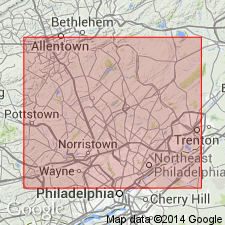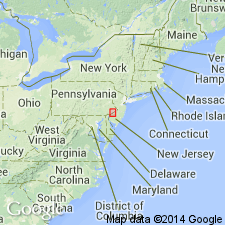
- Usage in publication:
-
- Pottstown shales
- Modifications:
-
- Named
- Dominant lithology:
-
- Shale
- AAPG geologic province:
-
- Newark basin
Summary:
Soft red calcareous shales at Pottstown and northeastward in the area between the Delaware and Schuylkill Rivers are named Pottstown shales, the uppermost subdivision of the New Red series. Overlies Perkasie Shales. Thickness is 10,700 ft.
Source: GNU records (USGS DDS-6; Reston GNULEX).

- Usage in publication:
-
- Pottstown shales*
- Modifications:
-
- Overview
- AAPG geologic province:
-
- Newark basin
Summary:
The Triassic series in the Philadelphia district is represented by the Norristown, Gwynedd, Lansdale, Perkasie, and Pottstown shales. It is footnoted that N. H. Darton divides the Triassic into the Stockton formation, corresponding to the Norristown, the Lockatong formation, corresponding to the Gwynedd, and the Brunswick Shale, corresponding to the Lansdale, Perkasie, and Pottstown.
Source: GNU records (USGS DDS-6; Reston GNULEX).
For more information, please contact Nancy Stamm, Geologic Names Committee Secretary.
Asterisk (*) indicates published by U.S. Geological Survey authors.
"No current usage" (†) implies that a name has been abandoned or has fallen into disuse. Former usage and, if known, replacement name given in parentheses ( ).
Slash (/) indicates name conflicts with nomenclatural guidelines (CSN, 1933; ACSN, 1961, 1970; NACSN, 1983, 2005, 2021). May be explained within brackets ([ ]).

